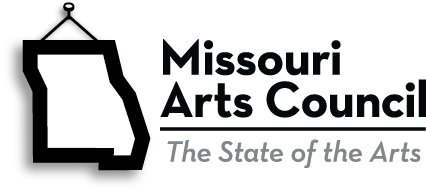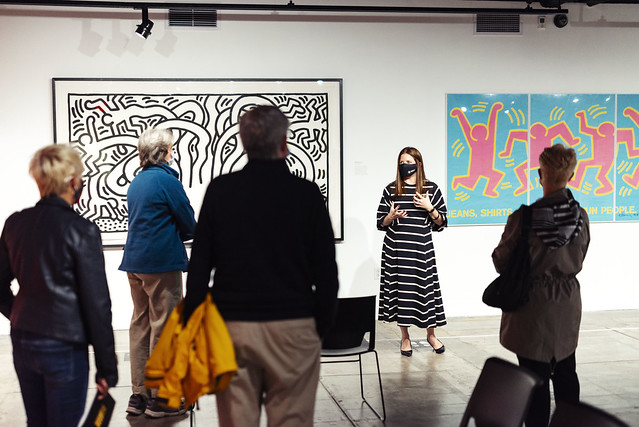Keith Haring: Radiant Gambit features artwork by Haring, a world-renowned pop artist known for his art that proliferated in the New York subway system during the early 1980s. The exhibition includes a never-before-seen private collection of Haring's works and photographs of the artist, bespoke street art chess sets from Purling London and newly-commissioned pieces by Saint Louis artists, all paying homage to the late pop culture icon.
Keith Haring (1958-1990) emerged as the shooting star of the New York art scene in the 1980s. Becoming world famous almost overnight, his simply drawn figures were soon to be found on watches and cars, T-shirts, and shopping bags, turning Haring into one of the best- known artists of his generation.
He was born in Reading, Pennsylvania, on May 4, 1958, and was raised in nearby Kutztown. As a child, Haring developed a love for drawing. He was fascinated by the cartoon art of Walt Disney and Charles Schultz and the illustrations of Dr. Seuss. He graduated from high school in 1976 and studied at the Ivy School of Art in Pittsburgh, a commercial arts school. After dropping out, after two semesters, he continued to create art and had a solo exhibition at the Pittsburgh Arts and Crafts Center in 1978.
In 1978, Haring moved to New York City to attend the School of Visual Arts. He then discovered a thriving alternative art community that was developing outside of the formal museum and gallery setting but rather in the streets of downtown New York, clubs, and the subways. He became friends with fellow artists Kenny Scharf and Jean-Michel Basquiat, musicians such as Madonna, and other performance and graffiti artists who comprised the burgeoning art community. Haring thrived with this crowd and energy and began exhibiting in and organizing exhibitions and performances in alternative spaces.
In addition to being impressed by the innovation and energy of his contemporaries, Haring was also inspired by the work of Jean Dubuffet, Pierre Alechinsky, William Burroughs, Brion Gysin, and Robert Henri's manifesto The Art Spirit, which asserted the fundamental independence of the artist. With these influences Haring was able to push his own youthful impulses toward a singular kind of graphic expression based on the primacy of the line. Also drawn to the public and participatory nature of Christo's work, in particular Running Fence, and by Andy Warhol's unique fusion of art and life, Haring was determined to devote his career to creating a truly public art.
In 1980, Haring received public attention with his public art in subways. He had found a highly effective medium that allowed him to communicate his work with a wider audience, and he created white chalk drawings on the unused advertising panels covered with matte black paper in subway stations. He considered the subways to be his "laboratory." Between 1980 and 1985, he produced hundreds of these "subway drawings." His signature images included dancing figures, a "radiant baby" (a crawling infant emitting rays of light), a barking dog, a flying saucer, large hearts, and figures with televisions for heads. These graffiti drawings became familiar to New York commuters, who would often stop to engage with the artist. He also attracted the attention of the city authorities which arrested him for vandalism on numerous occasions.
Between 1980 and 1989, Haring achieved international recognition and participated in numerous group and solo exhibitions. His first solo exhibition in New York was held at the Westbeth Painters Space in 1981. In 1982, he made his Soho gallery debut with an immensely popular and highly acclaimed one-man exhibition at the Tony Shafrazi Gallery. During this period, he also participated in renowned international survey exhibitions such as Documenta 7 in Kassel, the Sao Paulo Biennial, and the Whitney Biennial. Haring completed numerous public projects in the first half of the 1980s as well, ranging from an animation for the Spectacolor billboard in Times Square, designing sets and backdrops for theaters and clubs, developing watch designs for Swatch and an advertising campaign for Absolut vodka; and creating murals worldwide.
In 1986, Haring opened a retail store called the Pop Shop in Soho, New York in order to provide people greater access to his art at a low price point. The shop sold T-shirts, posters, magnets, toys, and buttons bearing his images. Haring believed that the entire shop was a piece of his art and painted black and white murals throughout the entire space.
Throughout his career, Haring devoted much of his time to public works, which often carried social messages. He produced more than 50 public artworks between 1982 and 1989, in dozens of cities around the world, many of which were created for charities, hospitals, children's day care centers and orphanages. The now famous Crack is Wack mural of 1986 has become a landmark along New York's FDR Drive. Other projects include: a mural created for the 100th anniversary of the Statue of Liberty in 1986, on which Haring worked with 900 children; a mural on the exterior of Necker Children's Hospital in Paris, France, in 1987; and a mural painted on the western side of the Berlin Wall three years before its fall. Haring also held drawing workshops for children in schools and museums in New York, Amsterdam, London, Tokyo, and Bordeaux, and produced imagery for many literacy programs and other public service campaigns.
Throughout his brief career, Haring was featured in more than a hundred solo and group exhibitions and produced more than 50 public artworks in cities around the world many of which were created for charities, orphanages, hospitals and children's day care centers. He also designed around 85 posters. These included advertisements for exhibitions of his own work as well as cultural events or political issues. Haring's drawings themselves incorporate the clear cut lines and reduced features needed for effective posters, which have to stand out and be understood at a glance. The uni-colored backgrounds help to make the outlined figures and drawings even clearer. The content of the advertisement is apparent in the illustration — the text being of secondary importance. Haring's colorful posters, with their precise pictorial language, direct messages, and universal appeal, still exert an incomparable fascination on us to this day.
Haring was socially conscious, and his murals often reflected his position on social issues. He sought to raise awareness of AIDS and fought against the proliferation of illegal drugs.
In 1988, he was diagnosed with AIDS. The following year, he created the Keith Haring Foundation in order to raise awareness of AIDS and to provide funding to AIDS organizations and children's programs, which is still in operation today. They continue to promote his artwork and his messages through the support of exhibitions, like this one at the World Chess Hall of Fame, various publications, and the licensing of his images.
Keith Haring died of AIDS-related complications on February 16, 1990, at the age of 31. During his very brief career his work was featured in over 100 solo and group exhibitions. In 1986 alone, he was the subject of more than 40 newspaper and magazine articles. He was highly sought after to participate in collaborative projects, and worked with artists and performers as diverse as Madonna, Grace Jones, Bill T. Jones, William Burroughs, Timothy Leary, Jenny Holzer, Yoko Ono, and Andy Warhol.
By expressing universal concepts of birth, death, love, sex, and war, using a primacy of line and directness of message, Haring was able to attract a wide audience and assure the accessibility and staying power of his imagery, which has become a universally recognized visual language of the 20th and 21st centuries. His work is part of significant private and public collections including the Whitney Museum of American Art, the Los Angeles County Museum of Art, the Art Institute of Chicago, the Musee Art Moderne de la Ville de Paris, the Carnegie Museum of Art, The Andy Warhol Museum, and the Stedelijk. His murals still exist throughout the world.
By Shannon Bailey, Chief Curator.
Special thanks to the Keith Haring Foundation and Katharine Wright, PhD, for providing content for this biography.
Downloads
Keith Haring: Radiant Gambit exhibition booklet
Keith Haring: Radiant Gambit Activity Book:
Stan Chisolm Coloring Section:

Single Source Travelling Exhibition organized by: Pan Art Connections Inc. www.pan-art-connections.com

Keith Haring: Radiant Gambit is supported by the Missouri Arts Council, a state agency.
Press
6/11/2021: St. Louis Magazine — Congratulations, A-List 2021 winners and finalists!
5/16/2021: Insider Hook — A New Exhibit Offers a Comprehensive Overview of Keith Haring’s Art
5/15/2021: Hyperallergic — The Darker Side of Keith Haring
5/13/2021: KSDK — Keith Haring art on display in St. Louis
5/12/2021: River Front Times — St. Louis' World Chess Hall of Fame Hosting Massive Keith Haring Exhibit
5/11/2021: CWE Scene — “Keith Haring: Radiant Gambit” Closing Reception
4/15/2021: Artvoice — World Chess Hall of Fame Celebrates Keith Haring
4/13/2021: Artlyst — Keith Haring: Personal Spiritual Imagery – Revd Jonathan Evens
4/10/2021: Peace and Love Lifestyle — Upcoming Chess Prodigies
4/8/2021: Stuck At The Airport — THE PLACES WE’LL GO: WORLD CHESS HALL OF FAME
4/1/2021: American Towns — St. Louis Featured Events - Exhibition - Keith Haring: Radiant Gambit
4/1/2021: Newsbreezer — Keith Haring also performed her famous street chess in the Hall of Fame Chess Players
3/29/2021: Art Daily — World Chess Hall of Fame exhibition celebrates the legacy of Keith Haring
3/25/2021: CWE Scene — 5 Things To Do In The CWE This Weekend: March 25-28
3/11/2021: Stay Happening — Curator Tour: "Keith Haring: Radiant Gambit" and "Masterminds: Chess Prodigies"
1/15/2021: Fox 2 News — Pop artist Keith Haring exhibit now on display at the St. Louis World Chess Hall of Fame
1/14/2021: travelandleisure.com — Art and Chess Combine at the World Chess Hall of Fame's Incredible Keith Haring Exhibit
1/14/2021: STL Magazine — https://www.stlmag.com/culture/radiant-gambit-world-chess-hall-of-fame-k...
1/7/2021: fordors.com — Love"The Queen's Gambit"? Then You Might Like These 7 Places
1/7/2021: choicehotels.com — Top Things to Do with Kids in St. Louis
12/17/2020: HEC TV — Keith Haring: Radiant Gambit at the World Chess Hall of Fame
11/10/2020: New York Times — 'Queen's Gambit' Clothes Make Us Want to Toss Our Leggings
Curator Tour: "Keith Haring: Radiant Gambit" and "Masterminds: Chess Prodigies"
Thursday, March 25 10am
Read MoreCurator Tour: "Keith Haring: Radiant Gambit" and "Masterminds: Chess Prodigies"
Thursday, March 11 5pm
Read MoreCurator Tour: "Keith Haring: Radiant Gambit" and "Masterminds: Chess Prodigies"
Thursday, February 25 2pm
Read MoreCurator Tour: "Keith Haring: Radiant Gambit" with Dail Chambers
Thursday, December 17 10am
Read More
